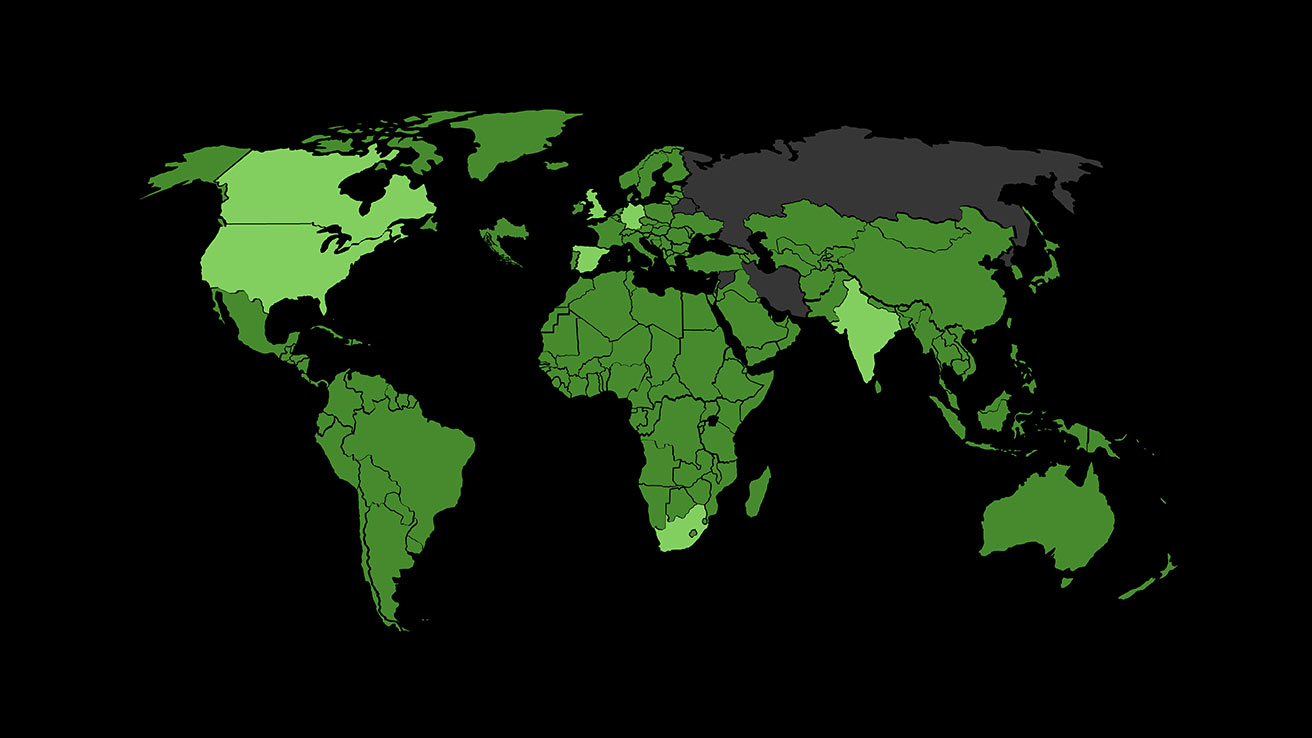How to identify the right SMS provider for global SMS success.
How does global SMS messaging work? And what should you look for in a network carrier for secure, compliant, and efficient SMS? Let’s take a look.
Contents
To get global SMS right, an SMS provider with the right carrier connections, infrastructure, and certification to connect with your customers quickly and securely – no matter where they are.
Remarkable to think that SMS was never designed for consumer messaging. And yet, some three decades after the first SMS message was sent in 1992, SMS remains one of the most popular forms of global communication.
The direct and universal nature of SMS makes it an ideal way to personally engage with your customers on their devices. And that includes orchestrating meaningful one-way and two-way interactions that can amplify your global reach, drive revenue, and build trust.
86% of US businesses used SMS to interact with customers in 2022 and more than half of consumers want the ability to text businesses back.
In this article, we’ll unpack how global SMS works, what to look for in an SMS provider for global and bulk SMS success, and how to orchestrate all your customer interactions in one place.
If you want to find out how to effectively engage with your customers using SMS we would recommend reading these two articles.
What is global SMS?
Global SMS, or global Short Message Service, is the ability to send and receive text messages internationally. This means you can connect with customers anywhere in the world using their phone's native messaging app.
With an impressive open rate and near-instant delivery, SMS allows businesses to engage with their customers in real-time, no matter where they are. Whether you're sending urgent notifications, marketing campaigns, or customer service messages, global SMS ensures your message gets received and seen quickly.
In order to send global SMS successfully it's essential to choose an SMS provider with efficient carrier connections and compliance with international regulations. This guarantees that your messages are delivered fast and securely.
How does global SMS messaging work?
Mastering global SMS messaging, including bulk messaging, is a delicate and often demanding process. Complex regulatory boundaries can have a significant impact on the speed and integrity of your customer interactions. Similarly, the way SMS providers connect and protect SMS activity can impact the ways you need to approach SMS. To understand how to send global SMS, you first need to have an idea on how messages are routed.
Message routing
When a message is sent from one mobile phone user to another, it goes through a process of routing to reach the recipient which can involve:
An SMS provider (aggregator)
Any intermediary network carriers if needed
Recipient's network carrier
On top of which, for messages to be exchanged between users on different networks or in different countries, there needs to be agreements between the SMS providers and network carriers. These interconnection agreements outline the terms for routing and delivering messages across networks.
For global SMS it’s unlikely there’s a single telecoms network with a direct link from your location to your customer so it needs to make connecting stops on the way - much like an international flight. Plus, global SMS compliance laws may prevent things like two-way SMS, A2P, and promotional messaging. This means when you send international SMS, the messages will take more hops to get where they are going or, in the worst-case scenario, get blocked for noncompliance.

SMS sent in one country
A relatively direct process when on the same network. When a message is sent it requires one or less “hops” and arrives almost instantly.
SMS sent globally
The sender's local carrier checks if it has a direct agreement with the recipient's carrier. If it does, the message is sent directly, otherwise it's routed through intermediary carriers or through SMS gateway providers until it reaches the recipient's carrier.
Impact of global SMS hops
Let's have a look at what an international SMS journey can look like between two different SMS API providers to show how additional hops can add more risk in sending global SMS. In this scenario you want to send a message to a customer based in Vancouver from your local network in Florida.
Provider Bravo
API conversion: Your text message is converted into an SMS packet by the SMS providers API server in Florida.
Data processing: Short message service center (SMSC) stores a copy of the SMS and works with a mobile switching center (MSC) to find the best route.
Direct connection: Bravo has a direct connection from its network in Florida to the receiver’s network in Vancouver.
Network transmission: SMS gets sent from Bravo’s network and interconnects with receiver’s local network provider in Vancouver.
Message delivered: Customer's network in Vancouver takes the SMS, makes a copy in their SMSC, and delivers the message.
Provider Delta
API conversion: Your text message is converted into an SMS packet by the SMS providers API server in Florida.
Data processing: SMSC stores a copy of the SMS and works with the MSC to find the best route.
No direct connection: Provider Delta does not have a direct connection to Vancouver. Instead, they rely on multiple carriers for routing the message. Delta forwards the SMS across its network to an interconnect with carrier 1 in Colorado.
Carrier 1: From Colorado, carrier 1 stores a copy of the SMS and forwards across it's own network to interconnect with carrier 2 in Washington, since this first carrier cannot directly route to Vancouver.
Carrier 2: From Washington, carrier 2 has a direct route with Vancouver established, so they store a copy of the SMS and forward across its own network to Vancouver.
Messaged delivered: Customer's network in Vancouver takes the SMS, makes a copy in their SMSC, and delivers the message.
Unlike provider Bravo, provider Delta could not directly route the message to the customer in Vancouver and so involved two carriers to help send the message. Each SMS hop adds more risk and opportunities for disruption, including:
Additional latency between the sender and recipient
Increased server exposure widens the attack surface
More opportunities for noncompliance and failure
So, what’s the solution? You’ll want to use an SMS provider with a global traffic hub that includes direct connections to your customers’ mobile networks. This removes the need to hop messages across multiple partner hubs, ensuring your SMS content arrives at its destination promptly and safely.
How to identify the right global SMS provider
1. Access to a Tier 1 network.
A Tier 1 network connects directly to other mobile networks for reliable and cost-effective SMS messaging, with zero data transferred through third parties. In comparison, Tier 2 networks use “blended” SMS routes which require more hops and often block or limit features such as sender ID and delivery reports.
Ideally, your SMS provider will use intelligent routing to automatically determine the best route for your global SMS, whether that’s a one-way customer alert or a two-way service interaction. The messages will then pass through its international traffic hub to connect directly with global carriers and aggregators for the fastest and most reliable coverage possible.
The best Tier 1 SMS aggregators or providers also offer bespoke customer services that simplify campaign management. This includes real-time delivery receipts, detailed error codes, number lookup assistance, branded text, and even Unicode support to help you seamlessly engage customers in their local and regional languages.
Expand your reach across SMS and beyond, read our Messaging Network guide to find out more.
2. Secure global certification.
As we’ve explored previously, global SMS messaging requires a great amount of care, especially when it comes to regulatory compliance and protecting sensitive data.
At a minimum, your network carrier should include built-in controls for GDPR, HIPAA and CCPA, and ISO 270001 for out-of-the-box regulatory compliance. It should also use VPN tunnels and SSL (TLS V.1.2) to encrypt data over public and private networks, and 10-digital long code (10DLC) numbers to reduce the risk of SMS-based phishing attacks.
As your SMS provider will handle huge volumes of international SMS traffic, it’s important that they use a network operations center (NOC) to proactively monitor and react to issues that may affect service efficiency or breach regional compliance. This includes consent management, monitoring for spam, malicious traffic, and third-party data exposure.
3. A single platform for futureproof messaging.
Your SMS provider may offer multiple ways to use its network, including APIs for gateway integration, dedicated point solutions for specific use cases, or a cloud-based Communications as a Service (CPaaS) platform.
For large and medium enterprises, we recommend an enterprise-grade CPaaS platform to automate and build end-to-end customer journeys across multiple channels - including SMS. And with a single, centralized view of all communications, it’s never been simpler to meet your customers in the right place with timely, personalized interactions.
Your CPaaS platform should also include flexible integrations that connect your existing business systems to new digital channels, helping you unlock siloed insights and keep pace with shifting customer preferences. Plus, with bulk SMS services and global aggregators, you can easily orchestrate mass text messaging across multiple regions quickly and cost-effectively.
Webex CPaaS solutions has you covered
Webex Connect is an enterprise-grade CPaaS platform purpose-built to help businesses like yours orchestrate and automate customer journeys that help raise awareness, build brand loyalty, and engage customers in meaningful two-way relationships.
Underpinning Webex Connect is our Messaging Network - a global messaging infrastructure designed around resilience, redundancy, and low latency. What’s more, we take proactive care to ensure our network is always compliant with the latest global laws and regulations, such as GDPR, HIPAA, CCPA, ISO 270001 and more.

Our global reach showing tier 1 and tier 2 connections.
That’s why enterprises trust us to send and receive billions of SMS messages worldwide – including two-way bulk SMS interactions spanning multiple regions and contextual requirements. And by combining our high-performance Messaging Network and Webex Connect, you get a scalable, secure, and futureproof platform for next-generation customer interactions.
Get in touch with us today to learn how our global SMS service can expand your customer communications strategy or check our SMS page for more information.